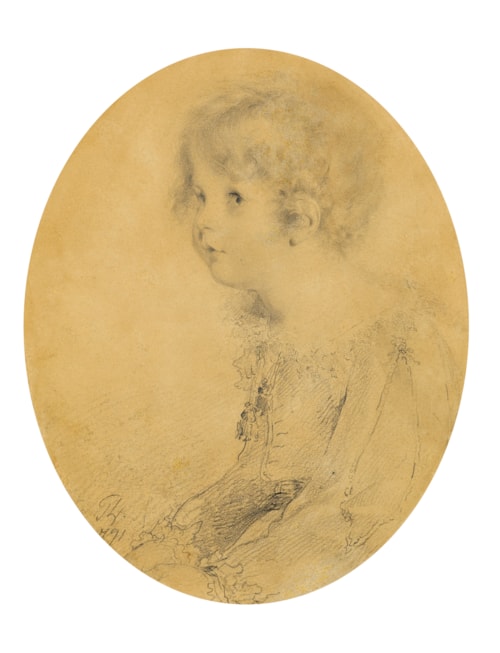
Thomas LAWRENCE
Bristol 1769 - London 1830
Biography
The leading portrait painter of his generation in England, and indeed arguably in Europe, Sir Thomas Lawrence was, from his early childhood, recognized as a brilliant and gifted draughtsman, and it was through his drawings that he established his initial reputation. (When he first exhibited at the Royal Academy in 1787 he showed a total of seven works, all of which were drawings or pastels.) Indeed, his abilities as a draughtsman are all the more notable in that it was a skill in which he was, for the most part, self-taught.
The importance of drawing in Lawrence’s artistic process throughout his career cannot be overstated. He began each portrait painting by drawing in oiled black chalk on the canvas, and also created a large number of both preparatory studies and autonomous portrait drawings, deftly executed in red and black chalks. As Cosmo Monkhouse noted of Lawrence, ‘As a draughtsman, especially of faces and hands, he is scarcely equaled by any English artist…His most perfect works are his drawings in crayon and pencil, which he continued to execute throughout his life.’ More recently, Michael Levey has further noted of the artist that, ‘It is not just that Lawrence had been profoundly trained – self-trained – as a draughtsman and that he continued to draw expertly throughout his life. For him, drawing was the method by whereby he pinned down his prime visual sensations.’
Lawrence’s ability as a draughtsman continued to be praised long after his death. Writing in 1913, one noted art critic wrote that, ‘Of the many who admire Sir Thomas Lawrence, as one of the most individual and fascinating of English portrait painters, few realise that he was greater with the pencil than with the brush; and that the grace and elegance which characterise his art are more superbly expressed in the delicate tints of water-colour than in the heavier, more solid, and more opaque oil pigments…Lawrence thought in pencil what he expressed in oil. Unlike his great contemporaries and predecessors, he found it necessary to make elaborate drawings from his sitters before setting down their likeness in color. Thus it is almost only in his drawings that he attained that perfect ease and spontaneity of expression which is the hall-mark of a great master.’
It has been noted that, among Lawrence’s contemporaries, perhaps only Jean-Baptiste-Dominique Ingres in France may be said to have been his equal as a draughtsman in the delicacy and precision of his technique. It was also Lawrence’s close study and appreciation of the great draughtsmen of the past that led him, once he had achieved considerable success, to assemble one of the finest collection of Old Master drawings ever put together in Britain.




